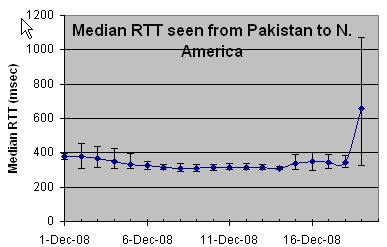...
Examples of the increase in RTT can be seen below in the plot of RTT seen from SLAC to two hosts in Egypt, a host at the Lahore School of Economics Pakistan and a host at the NCP provider in Pakistan, a host in Bahrein, one in Oman, one in Bangladesh (www.brauniversity.net) and one in OmanJordan. All show an increase in RTT around 9-10am on Friday Dec 19th 2009 (UDT). In the case of the www.tanta.edu.eg host in Egypt no loss of connectivity was observed at the time of the cut. However for the frcu.edun.eg besides the increase in RTT frequent losses of connectivity are observed and the link appears to be restored on January 23rd (www.frcu.edu.eg recovered at about the same time). In the case of Lahore there was a short period of no connectivity and over the days of the outage the RTT varied dramatically dropping back to normal and full recovery did not appear to be complete by January 27th. NCP had a small increase in RTT and a long period of no connectivity later on Friday stretching into Saturday. The Bahrein host experienced large changes in RTT between daytime (busy times, more congested, more queing and longer RTTs) and night-times. The increase increases in RTT during eth the daytime for Oman were extremely large (~ 5 seconds), however the problem appears by-passed/fixed by December 23rd. The Bangladesh host follows a very reproducible pattern switching between 250ms at night and 300ms RTT for the rest of the time and the effect continues to at least the end of December 30th. The Jordan host is less regular in its behavior and there is little effect on the weekend (Dedcember 20the & 21st) following the start of the outage. These graphs illustrate the variability of the impact even within a country.
Another view of the effect of the RTT increases is seen in the plot below of the median RTTs measured (thed error bars are the 25% and 75%-tiles) from 3 monitoring hosts in Pakistan (NUST, COMSATS and NCP) to FNAL and SLAC (i.e. 6 pairs of monitor/remote hosts) for the first 19 days of December 2008.
...








